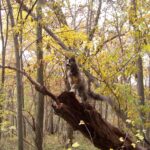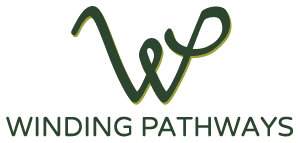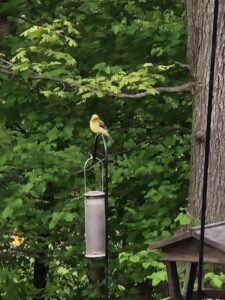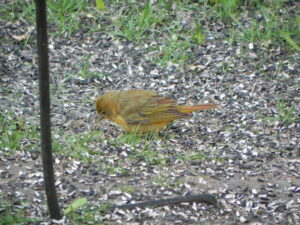by Winding Pathways | Jul 9, 2020 | (Sub)Urban Homesteading, Garden/Yard
One morning while watching the arrival of spring migrant birds, we were startled and annoyed to see a cat lurking under the feeder seeking a bird victim. We so enjoy the Summer and Scarlet Tanagers, and Indigo Buntings at our feeders. They add diversity to our usual visitors – titmice, chickadees, cardinals, and woodpeckers who visit throughout the year.
We chased the cat away but began researching the history of domestic cats and their impact on wildlife. It’s both fascinating and concerning.
Challenges Facing Birds
Modern birds face many challenges, including habitat destruction, climate change, light pollution that disrupts navigation, and crashing into towers. However, the International Union for Conservation of Nature lists domestic cats as one of the world’s worst nonnative invasive species. They are the number one human-caused threat to birds in the United States and Canada and kill upwards of 2.4 billion a year.
Domestication of Cats
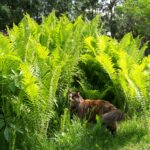
Cats have a strong hunting instinct.
People and cats have a long relationship. They were domesticated from the European wildcat over 10,000 years ago, probably in the Fertile Crescent. Wherever people have migrated to they’ve brought along cats. Even after so many years living with people this animal, Felis sylvestris, retains its predatory instincts, reproduces rapidly, and readily goes wild, or feral.
Domestic cats are fascinating animals loved by millions of people, so any criticism of them often brings a sharp emotional response. However, there’s no doubt they harm wildlife, and one of the main reasons is their artificial high population density.
Animal Territories
Wild predators, like cougars, bobcats, and wolves have vast territories. It takes plenty of land to sustainably produce enough prey for a predator to live. So, if they are crowded together they’d starve. A naturally occurring population of predators in a healthy ecosystem simply has few individuals. For example, a healthy population of native bobcats may have only a few individuals spread over several square miles. The same goes for wild native European wildcats in natural areas in Asia and Europe. The problem comes when humans crowd many cats into a small area.
Families that don’t want cats stalking birds can take a few actions to reduce the death toll of birds. These include:
- Asking neighbors to keep their animals in their home or yard.
- Placing feeders on metal “shepherd’s hooks” that cats can’t climb.
- Configuring a ring of wire mesh around feeding stations to exclude cats from catching juncos, chipping sparrows, and other ground-feeding birds.
Birds face many hazards in this modern world. Cat predation is one that can be reduced. Both cats and birds can enjoy a safer life if the owners of descendants of the European wildcat kept their pets indoors.
by Winding Pathways | Jul 2, 2020 | (Sub)Urban Homesteading, Garden/Yard, Nature
Prairie Seedlings
Tuesday, June 2nd was an exciting day. We walked to our 3,000 square foot patch of dirt that, until recently had been a lawn, and spotted bits of feathery green poking through the dirt. They were baby partridge peas, scattered somewhat evenly through the patch.
Last winter we decided to extend our long-term effort of transforming mowed lawn into the native prairie. In our first blogs, called Prairie Renaissance, we shared why we are doing this, early planning, and ground preparation, and seeding. You can view these on windingpathways.com. This blog tells how we manage our newly planted prairies and some of the tools we use.
Tools for Prairie Management*
*Most tools we bought ourselves. The EGO trimmer we received for testing
By far the most important “tool” for establishing a prairie is Patience. Seed a conventional lawn in the spring and it’s well established that same year. Roll out the sod and the lawn is immediate. Not so with the prairie. It needs time.
When we planted one of our first prairies in the 1980s at the Indian Creek Nature Center Jock Ingels was our mentor. His words ring true. Here’s what he said after advising us to scatter prairie seed on existing bromegrass”Plant those seeds and early next spring burn the grass. Then look carefully. You won’t see any prairie plants and think you wasted your time. Don’t give up. Burn off the grass that autumn or the next spring and watch again. You might see just a few prairie plants that year but still think you’ve wasted your time. But by the third year, the miracle starts. You’ll see more prairie plants, and it will keep getting better and better each year after.”
He was right. Planting a prairie on the existing brome is an exercise in patience. We did it because we had no money for herbicides or ground preparation. For our new prairie at Winding Pathways, we wanted to speed up the process by killing the existing lawn and baring the soil. It’s a “fast” way to start a prairie, but that’s relative. It still takes patience.
Partridge pea is a prairie sprinter. It’s an annual that shows up the first year with its pretty legume yellow bloom. Ours will bloom this summer and, if all goes well, we’ll also have Coreopsis and Black-Eyed Susans soon welcoming bees and butterflies. Newly planted prairies usually bloom with yellow flowers the first few years, while blue and red-toned flowers take longer to establish. So, we expect “yellow” in 2020 and gradually more color and species diversity as the years progress.
Planting a prairie is a little more like planting a tree than a vegetable or conventional flower garden. Patience helps.
Hands-on Tools to Help Manage Our Prairies
- Hand and battery-powered clippers to remove fast-growing weeds.
- We bought a self-propelled power lawnmower – EGO Mower. It’s quiet, effective, and inexpensive to operate.
- A battery-powered string trimmer. This allows cutting weeds higher than most lawnmowers.
- Plant identification books, especially those that have photos of seedlings and butterflies. Many books and websites help identify both prairie plants and weeds as well as insects and spiders. We recently have begun using an app called SEEK, produced by the National Geographic Society and the World Wildlife Fund. It’s free. You snap a photo of the plant, bird, insect, or fungus you want to identify and, presto, most of the time it immediately tells what it is. Many books and online resources help identify mature and blooming plants but seedlings are challenging. An outstanding guide for identifying prairie seedlings is PRAIRIE SEEDLING AND SEEDING EVALUATION GUIDE, which is available by PDF by simply Googling the publication’s name.
-
-
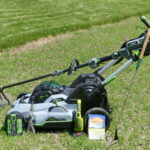
-
We use a variety of tools to manage the emerging prairie.
-
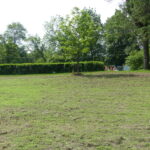
-
By early June a blush of green carpeted the upslope.
-
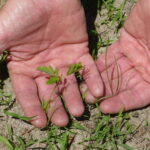
-
Partridge pea is an easy prairie plant to identify.
First Year Prairie Management
Transforming a lawn to a prairie doesn’t eliminate maintenance but it does reduce it. In its first year, a prairie needs special attention. Broadcast prairie seeds on bare ground and soon weeds march right in. In their establishment state prairie plants prioritize root growth over leaves. A rank growth of weeds can snuff them out. Young prairie plants are difficult to identify but generally hug the ground while weeds reach for the sky.
So, for the first two years, we will mow our prairie at the highest height our mower can be set at. This buzzes off the interloping weeds and lets the shorter prairie have sunlight. We’ll mow it three or four times the first year, one or two the second, and then quit mowing altogether once the prairie is established. Sometimes we use our battery-powered string trimmer to cut weeds higher than our lawnmower allows or in places where the ground is rough and the mower doesn’t work well. Future maintenance will involve burning and occasionally clipping out weeds.
Fertilizer and Water
Weeds love fertilizer. Prairie plants don’t need it. There is an irony. Over thousands of years dying prairie plants, especially their roots, created the wonderful topsoil of today’s Corn Belt, yet they do well in poor soil. We never fertilize our prairies. They just don’t need it, and if we did sprinkle some on our plantings the weeds would appreciate it and grow even faster.
The same for water. Prairies are drought tolerant. Their roots penetrate upwards of 15 feet down, drawing water from the subsoil. Watering a prairie mostly helps shallow-rooted weeds. We also completely avoid pesticides and herbicides, with the exception of killing the sod before our initial planting.
A perfect lawn needs infusions of water, fertilizer, and chemicals that stimulate so much growth that frequent mowing is needed. In contrast, a prairie doesn’t need them and, once established, needs little to no mowing.
An Excellent Resource
The Monarch Research Project is doing amazingly good work encouraging people to plant native species that make our world more beautiful and boost populations of beneficial wildlife, especially monarch butterflies. Their website is a host of information and has outstanding webinars on why and how landowners can make our earth a healthier place.
-

-
Black-Eyed Susans are biennials.
-
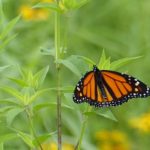
-
Monarch
-
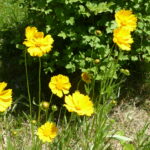
-
By summer we may see Coreopsis.
Our Next Prairie Renaissance blog will be in late summer when we’ll showcase both emerging prairie plants and some of the weeds that bedevil prairies. Later in the fall, a blog will detail prairie prescribed burning.
by Winding Pathways | Jun 25, 2020 | Birds, Garden/Yard, Nature
She feeds ’em. I shoot ’em.
Guest Bloggers STB
Yes, this sounds like a love/hate relationship. But, it is truly pure enjoyment for my wife and me to witness the birds that visit our backyard feeder here in SE Minnesota.
Throughout the year a variety of birds comes from the woods to feast at my wife’s feeder. From late April to early May the orioles make their appearance. Baltimore Orioles have a vivid bright orange color and the Orchard Oriole has a noticeably darker burnt orange color. The recent reality of retirement has allowed us more time for photography and our birds have become a passion.
Capturing a static image of a perched bird is relatively easy but my goal has been to catch them in their interactions and flight. Shutter speeds of 1/1000th of a second or faster are recommended and patience is mandatory but the results might get you hooked. Beware…
-
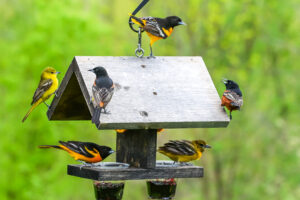
-
The jelly attracts the orioles.
-
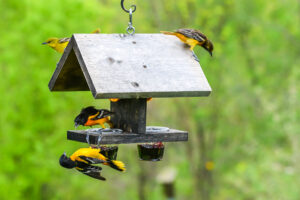
-
Sparring over rights to the jelly.
-
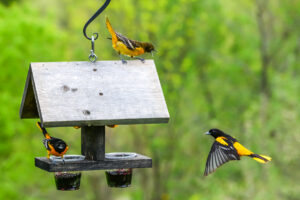
-
Warding off the in-coming oriole.
by Winding Pathways | Jun 18, 2020 | Birds, Garden/Yard, Nature
Another beautiful, blue-sky day. This early morning I am drinking tea and looking out the patio windows. As I enjoy the view of the freshly cut lawn and watch the birds flit about, a bit of busy-ness above the deck catches my attention. A small, loose clump of grey moss trembles and jerks around. It seems suspended like a little tube sock from a maple branch.
A tiny head and two bright eyes appear. In a wink, she’s gone. Moments later, another flash, this time with a hint of yellow. More trembling and jerking around, on the branch. And now I’m sure we have a nesting pair in our tree at the end of the deck.
Despite the yellow, her beak is too long and slender to be a goldfinch. A burst of warbling and I think it might be ‘Mistress Mary’, one of my favourite songbirds that keeps me company on long summer afternoons.
I can look forward to hours of entertainment.
Mistress Mary is just my name for a songbird whose phrases sound like an event organizer ordering people around:
“Jay-jay, sorry, Jo-Jo, sit here.”
“That’s your story?
“So?”
“Bring it here.”
“Will you do it?”
“Where are you?”
“Do ya think?”
She has quite a repertoire of a dozen or so phrases that she repeats faithfully. Fun to listen to. I first heard her about five years ago.
The Hermit thrush has also arrived in Eastern Canada for his summer stay. His ethereal song echoes in the woods.
Readers, scroll through the article in the New York Times to read an interesting article interspersed with bird sounds: Hear 13 Birds Flourishing in a Newly Quiet New York (City).
by Winding Pathways | Jun 11, 2020 | Birds, Garden/Yard, Nature
We’re lucky. Scarlet tanagers nest near us. Winding Pathways abuts Faulkes Heritage Woods, a protected 110-acre forest of mostly monstrous oak trees. So, every May we’re delighted as this brilliant bird arrives and sets up home.
Male scarlet tanagers appear at our feeders in mid-May. Females come a few days later. The male’s amazingly brilliant red feathers and contrasting black wings make the bird unmistakable. For only a week or two they visit the orange-colored suet we set out and pick sunflower seeds from silo feeders. Then they disappear. We knew they abandoned our yard to nest near the tops of big oaks in the nearby woods, but they are very hard to spot there, even as they sally forth to catch insects from mid-air catching a meal. Their summer diet is mostly insects.
-
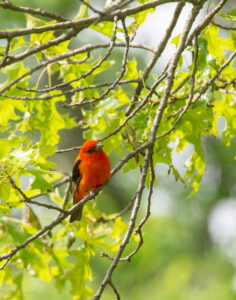
-
The male scarlet tanager arrives. several days ahead of the female.
-
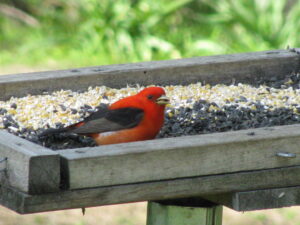
-
The tanagers willinging come to the platform feeder.
We wondered where they went after nesting and consulted our friend Jim Berry, retired executive director of the Roger Tory Peterson Institute in Jamestown, New York. Here’s what he wrote:
“Once the baby birds fledge, familial responsibilities end and the birds move away from forests to places where they can find food and molt. Often these are old fields and marshes, where they seem to disappear. This is called the post-season dispersal.
They soon replace their brilliant red feathers with duller-colored new ones that help them migrate.”
Jim told us we are lucky to have scarlet tanagers come to our feeders. They don’t where he lives in Western New York.
After they molt the birds fly all the way to northwestern South America for the winter. We won’t see them again until next May.
These are breathtakingly beautiful birds that brighten our yard for just a short while each year. We’re humbled to be able to host them.
by Winding Pathways | May 28, 2020 | (Sub)Urban Homesteading, Amphibians/Reptiles, Garden/Yard
For many years Rich wrote a nature column for the Cedar Rapids GAZETTE about little known aspects of natural history common in suburbia. He was amazed when more people responded to a column on toads than anything else he had written. People like toads. Some readers called him to talk about “their” toad that lives in the garden or a damp corner in the garage. They wondered what treats they could give “their” toad.
Toads Range Far and Wide
Toads herald spring’s arrival with lusty evening trilling, usually in May. Common and intriguing, they enjoy living in suburban yards as well as woodlands and wetlands.
Many toad species inhabit the world but the Eastern Toad is most common in the United States. It ranges from about Nebraska east to the Atlantic and from southern states north to nearly Hudson’s Bay in Canada.
Where do Toads Live?
Both toads and frogs are amphibians. (The bloopers at the end of this video are fun to watch! Shows what it takes to put together even one short educational video!)
Toads, however, spend much of their lives away from water. A damp shady place to live and plenty of insects and other invertebrates to eat suits their needs. Toads often spend the day hiding in damp garages, under rotting logs, and in secluded garden spots. Come evening they hop around seeking tasty bug meals.
As amphibians toads need standing water to reproduce. Each spring toads hop to ponds, wet road ditches, and big puddles to serenade the night with their loud trilling. Females lay two strings of eggs in the water that hatch into tadpoles within two weeks. The warmer the weather the faster the eggs hatch. Toad tadpoles are easy to recognize. They are tiny, black, and have bodies much larger than their thin tail. Often hundreds swarm in a small pool. In less than two months they change into mini toads that hop far and wide seeking a place to live. They’ll eventually grow to about three inches long.
-

-
Toads sing loudly day and night.
-
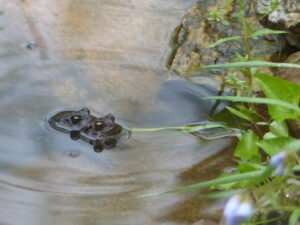
-
Toads need water to mate.
Who Eats Toads?
Although many animals enjoy a frog meal, few eat toads. When bothered toads often emit a foul-tasting liquid that makes a hungry dog or raccoon immediately drop the animal unhurt. Probably their main predator is the hognose snake, which relishes a toad meal.
Caring for “Your” Toad
Most people like toads and many gardeners create damp quiet places in their gardens for them to take shelter during the day and forage for pesky insects come nightfall. As for a toad treat, well, they really don’t need one but they might like to snack on a few mealworms or earthworms.
#

